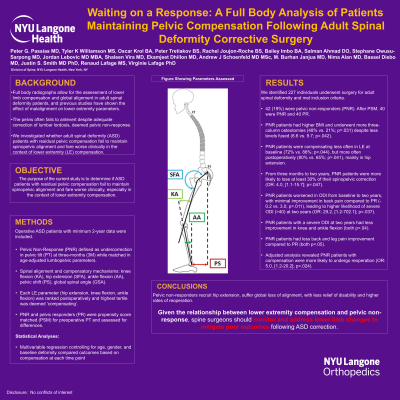Waiting on a Response: A Full Body Analysis of Patients Maintaining Pelvic Compensation Following Adult Spinal Deformity Corrective Surgery
Friday, April 21, 2023


Peter G. Passias, MD
Spine Surgeon
NYU School of Medicine
New Canaan, CT, US
ePoster Presenter(s)
Introduction: The pelvis often fails to antevert despite adequate correction of lumbar lordosis, deemed pelvic non-response. We sought to determine if ASD patients fail to maintain spinopelvic alignment and fare worse clinically in the context of pelvic and lower extremity(LE) compensation.
Methods: Pelvic Non-Response(PNR) defined as undercorrection in pelvic tilt(PT) at three-months(3M) while matched in age-adjusted lumbopelvic parameters. Each LE parameter(hip extension,knee flexion,ankle flexion) was ranked postoperatively and highest tertile was deemed ‘compensating’. PNR and pelvic responders(PR) were propensity score matched(PSM) for preop PT and assessed for differences. Multivariable regression controlling for gender, levels fused, invasiveness, and baseline deformity assessed outcomes between groups.
Results: Retrospective review of 227 ASD patients. 42(19%) were pelvic non-responders(PNR). After PSM, 40 were PNR and 40 PR. PNR patients had higher BMI and underwent more three-column osteotomies(48% vs. 21%,p=.031) despite less levels fused(8.6 vs. 9.7,p=.042). PNR patients were compensating less often in LE at baseline(72% vs. 86%,p=.044), but more often postoperatively(80% vs. 65%,p=.041), mainly in hip extension. From 3M to two-years(2Y), PNR patients were more likely to lose at least 30% of their spinopelvic correction(OR:4.0,[1.1-15.7];p=.047). PNR patients worsened in ODI from baseline to 2Y, with minimal improvement in back pain compared to PR(-0.2 vs. 3.0,p=.011), leading to higher likelihood of severe ODI(>40) at 2Y(OR:29.2,[1.2-702.1];p=.037). PNR patients with a severe ODI at 2Y had less improvement in knee and ankle flexion(both p < .04). PNR patients had higher back and leg pain compared to PR(both p < .05). Adjusted analysis revealed PNR patients with compensation were more likely to undergo reoperation(OR:5.0,[1.2-20.2];p=.024).
Conclusion : Pelvic non-responders recruit hip extension, suffer global loss of alignment, with less relief of disability and higher rates of reoperation. Given the relationship between lower extremity compensation and pelvic non-response, spine surgeons should monitor and address lower limb changes to mitigate poor outcomes following ASD correction.
Methods: Pelvic Non-Response(PNR) defined as undercorrection in pelvic tilt(PT) at three-months(3M) while matched in age-adjusted lumbopelvic parameters. Each LE parameter(hip extension,knee flexion,ankle flexion) was ranked postoperatively and highest tertile was deemed ‘compensating’. PNR and pelvic responders(PR) were propensity score matched(PSM) for preop PT and assessed for differences. Multivariable regression controlling for gender, levels fused, invasiveness, and baseline deformity assessed outcomes between groups.
Results: Retrospective review of 227 ASD patients. 42(19%) were pelvic non-responders(PNR). After PSM, 40 were PNR and 40 PR. PNR patients had higher BMI and underwent more three-column osteotomies(48% vs. 21%,p=.031) despite less levels fused(8.6 vs. 9.7,p=.042). PNR patients were compensating less often in LE at baseline(72% vs. 86%,p=.044), but more often postoperatively(80% vs. 65%,p=.041), mainly in hip extension. From 3M to two-years(2Y), PNR patients were more likely to lose at least 30% of their spinopelvic correction(OR:4.0,[1.1-15.7];p=.047). PNR patients worsened in ODI from baseline to 2Y, with minimal improvement in back pain compared to PR(-0.2 vs. 3.0,p=.011), leading to higher likelihood of severe ODI(>40) at 2Y(OR:29.2,[1.2-702.1];p=.037). PNR patients with a severe ODI at 2Y had less improvement in knee and ankle flexion(both p < .04). PNR patients had higher back and leg pain compared to PR(both p < .05). Adjusted analysis revealed PNR patients with compensation were more likely to undergo reoperation(OR:5.0,[1.2-20.2];p=.024).
Conclusion : Pelvic non-responders recruit hip extension, suffer global loss of alignment, with less relief of disability and higher rates of reoperation. Given the relationship between lower extremity compensation and pelvic non-response, spine surgeons should monitor and address lower limb changes to mitigate poor outcomes following ASD correction.
